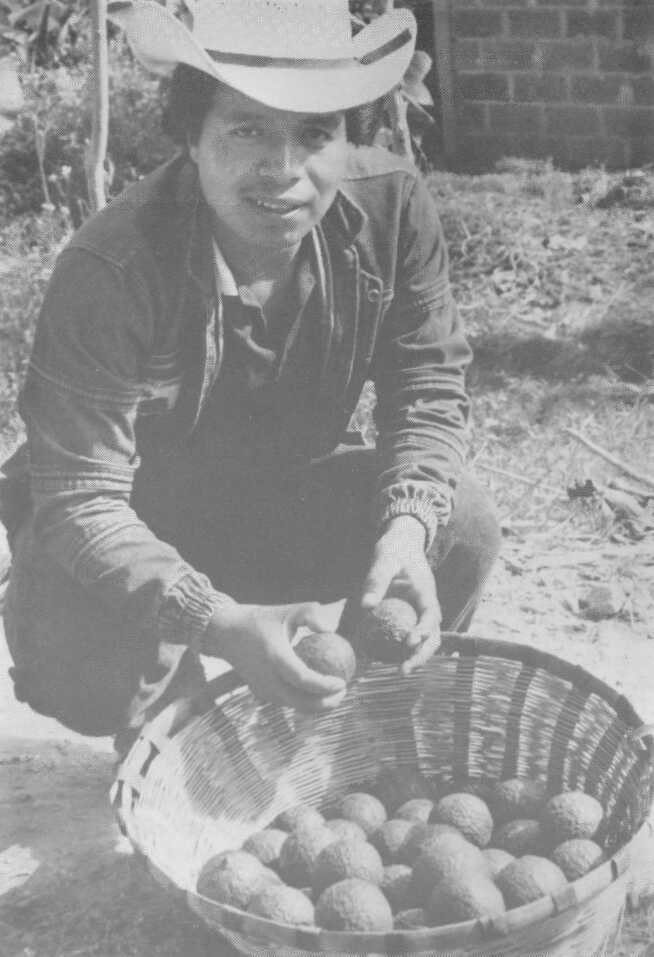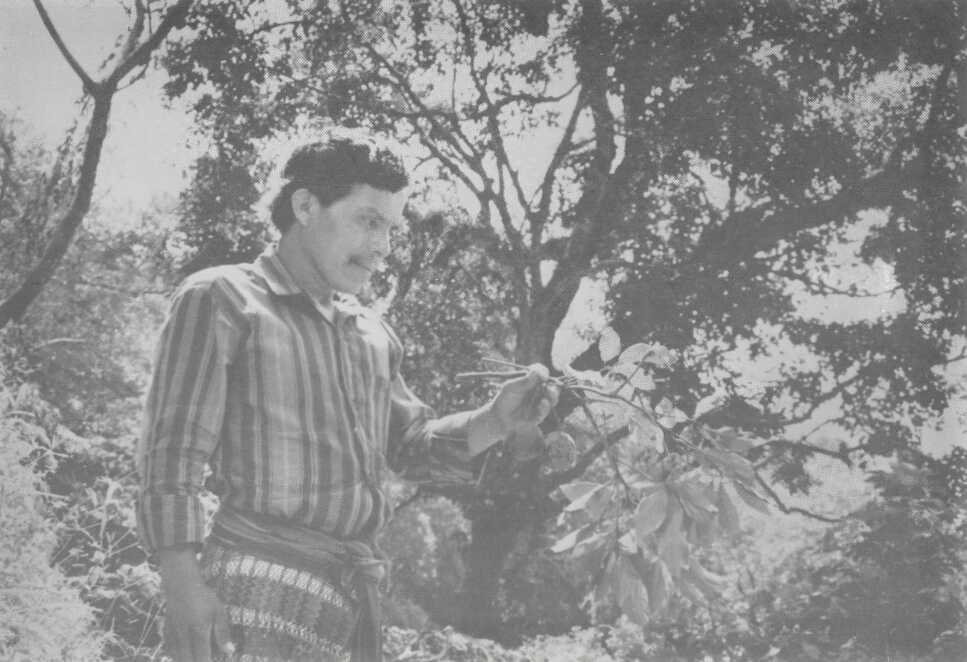Proc. of Second World Avocado Congress 1992 pp. 563-567
Ancestors of the Guatemalan "Criollo" (Persea
americana var. guatemalensis) as Studied in the Guatemalan Highlands
Eugenio Schieber
Antigua, Guatemala, Central America
George A. Zentmyer
Department of Plant Pathology, University of California,
Riverside, CA 92521, USA
Abstract. For 20 years
we have been exploring the highlands of Guatemala, as well as the warmer region
of Alta and Baja Verapaz, for wild avocados. The Guatemalan "Criollo"
group (Persea americana var. guatemalensis) has been one of the types of
Persea studied most intensively during these years, as well as the
possible ancestors of this group. We consider the ancestors of the Guatemalan
"Criollo" to be: 1) Persea nubigena, discovered by Wilson
Popenoe in 1935 in the central highlands; we have encountered several centers
or areas where this species grows, between 7000 and 8500 feet elevation; 2) Persea
steyermarkii, which grows at a similar elevation to P. nubigena in
the cold highlands; we have found this species in four centers; and 3) Persea
zentmyerii, a new species reported in 1987. These three species, along with
a close relative of the Guatemalan "Criollos", Persea tolimanensis
(Aguacate de Mico) reported in 1989, constitute the chain of ancestors of P.
americana var. guatemalensis, in our opinion.
The late Dr. Wilson Popenoe when consulted at his beautiful colonial home at Antigua, Guatemala, about any aspects related to "wild avocados" would say: "Yes, Gene and George, it is a mighty good article, but based only on herbarium specimens...". Then he would say with a smile: "...that fellow never was out in the field looking at our real stuff!"
Twenty years ago, when Prof. Zentmyer invited the first author to collaborate in his avocado rootstock exploration project, I thought, but I am a "jungle pathologist" with botany as a minor; but looking back to July, 1971, I saw a transformation, to become a "cloud-forest botanist" right in Middle America in the Mayan World. Responsible for this transformation were of course George Zentmyer and the great Wilson Popenoe.
This large scale collecting project for finding avocado germplasm resistant to Phytophthora cinnamomi was initiated in 1952 by the second author (Zentmyer, 1952). In the late 1940's, the California Avocado Society's Committee on Foreign Exploration had made several trips to Mexico and had collected significant material of potential commercial fruit types as well as some collections of other species of Persea that might be of use as rootstocks. C. A. Schroeder at UCLA was involved in some of these trips and propagated some interesting material at UCLA.
Our primary collections featured in this article are
basically from the highlands of Guatemala and involve four interesting species
of Persea that we feel were involved in the development of the
Guatemalan "Criollos" (Fig. 1). These, therefore.were involved in the
ancestry of commercial Guatemalan varieties such as Nabal, Benik, MacArthur,
Queen, and, more importantly, of Hass. (Hass, a chance seedling that developed
in California, has become the primary commercial
variety not only in California but in most of the other avocado-producing
countries.) The four species are P. nubigena, P. steyermarkii, P.
tolimanensis (Aguacate de mico) and P. zentmyerii.
Persea nubigena - This important species resembling a miniature typical Guatemalan "Criollo" was first found by Wilson Popenoe in 1935 (Popenoe, 1935) in the Guatemalan highlands near Tecpan. This collection was later identified and described by Williams (1950); Zentmyer collected seed for the rootstock program in 1956. This tree was reclassified by Kopp (1966) as P. americana var. nubigena.
Over the past 20 years the authors have found stands of this species from the Orizaba volcano in Mexico to Costa Rica (Schieber and Zentmyer, 1978). Schieber noted the largest stand of P. nubigena in 1976 in the Cuchamatanes range (Nuca-Bar-illas) in Guatemala. We have found variants of this native tree in several countries and especially within Guatemala. It and P. tolimanensis are the closest relatives of the Guatemalan "Criollos".
Persea steyermarkii - In 1978 (Schieber and Zentmyer, 1978), we wrote: "When we first detected trees of Persea steyermarkii in the remote cloud forest of 'La Lucha1 in western Guatemala [San Marcos], we took samples of fruit, inflorescences, leaves and branches to our friend in Antigua, the late Dr. Wilson Popenoe.
He marveled at seeing for the first time this important species of Persea: P. steyermarkii. He touched the leaves, then the fruit and the branches and exclaimed to both of us watching him in silence, "You made it. It is P. steyermarkii that I see for the first time as a living specimen."
This species is quite distinctive from P. nubigena
in the field (Fig. 2). Trees have quite a different aspect, different
foliage color and leaf venation, and the leaves are not as coarse as in P.
nubigena. The fruit is pyri-form with a small neck, in contrast to the
oblate-shaped fruit of P. nubigena. We have found several variants of
this species in the Guatemalan Highlands.
Persea steyermarkii has been described from only Guatemala and El Salvador. In Guatemala, we have made collections of this tree in four-centers from the Mexican-Guatemalan border to the Honduras-El Salvador border. The highest collection was in Maria Tecun, near the border of Solola and Totonicapan Departments; here this species grows at an elevation of over 8500 feet.
Persea tolimanensis - After observing the tree known as Aguacate de Mico for many years, we described it in 1990 as a new species of Persea: P. tolimanensis.
Zentmyer made the first collection of this unique tree from the volcano El Boqueron in El Salvador in 1954. In El Salvador, this tree is known also as "Aguacamico". Since the early collections, this species has also been found in Guatemala, Honduras, Nicaragua, and Costa Rica. Since a concentration of these trees has been studied for 14 years on the slopes and canyons of the volcano Toliman south of Lake Atitlan in Guatemala, the authors named this species P. tolimanensis (Zentmyer and Schieber, 1990).
This species is characterized by the thick-skinned (hard-shelled) fruit that is not edible and is eaten only by monkeys, hence the name of Aguacate de Mico in Central America. The fruit is typically oblate, dark green in color with irregular skin (Fig. 3). The fruit persists long on the tree after maturation.
The seed is comparatively large and also oblate similar to the fruit. The leaves are similar to those of P. americana var. guatemalensis, but are more opaque. The inflorescence is subterminal and either compact or loose. Branching usually begins very high in the tree and the trunk is whitish to gray.
The authors regard this species as one of the ancestors of the Guatemalan "Criollos".
Persea zentmyerii - In the fall of 1981, during the exploration of a cloud forest in northern Guatemala at about 3,500 feet elevation, P. zentmyerii was discovered. The young trees (about 10 years old and a seedling) were found in the Baja Vera-paz province, Purulha Municipality. The collection was recorded as Gu-1083 and was identified as a different Persea from any previously reported. This new species is characterized by large leaves, red new growth, and has a small fruit resembling a miniature P. steyermarkii with rough surface. The trunk is gray to dark brown with corky bark. The flowers are greenish-yellow and grouped in sub-terminal panicles or cymes.
Schieber and Bergh (1987) described this new species in the 1987 Yearbook of the California Avocado Society, and for the first time stated that this tree appears likely to be an important link in the evolutionary chain leading to modern commercial avocados, via the Guatemalan "Criollos".
Another Species of Persea from Xiquival - In 1978, we found what appeared to be a new species of Persea on the slopes of the volcano Xiquival, southwest of Quetzaltenango in Guatemala. For several years the authors considered this tree to be a variant of P. steyermarkii. However, in recent explorations when the three trees in the cloud forest of Xiquival were studied again, we believe that this may indeed by a different species of Persea.
The leaves of this new collection are very different in texture from the coarse, oak-like leaves of P. nubi-gena; the leaves of the Xiquival Persea are very smooth. The venation of Xiquival leaves is also different from both P. nubigena and P. steyermarkii. Inflorescences are terminal, compact to loose, and yellow-green in color. The fruit also differs from the fruit of the other two species, although in size the fruit of the Xiquival collection is similar to P. steyermarkii.
Literature Cited
Kopp, L. E. 1966. A taxonomic revision of the genus Persea in the Western Hemisphere (Persea-Lauraceae). Mem . New York Bot. Garden 14:1-117.
Popenoe, W. 1935. Origin of the cultivated races of avocados. Calif. Avocado So. Yrbk. 24:184-194.
Schieber, E. and B. 0. Bergh. 1987. Persea zentmyerii: a new species from Guatemala. Calif. Avocado Soc. Yrbk. 76:199-203.
Schieber, E. and G. A. Zentmyer. 1978. Exploring for Persea in Latin America. Calif. Avocado Soc. Yrbk. 67:60-63.
Schieber, E. and G. A. Zentmyer. 1978. Hunting for Persea steyermarkii in the mountains of Guatemala. Calif. Avocado Soc. Yrbk. 67:67-71.
Williams, L. 0. 1950. Two new Perseas from Central America. Ceiba 1:55-58.
Zentmyer, G. A. 1952. Collecting avocados in Central America for disease resistance tests. Calif. Avocado Soc. Yrbk. 32:107-111.
Zentmyer, G. A. 1980. Phytophthora cinnamomi and the diseases it causes. American Phytopathological Society Monograph 10, 96 pp.

Fig. 1. Guatemalan "Criollo" fruit, Rio Frio, Alta Verapaz, Guatemala, with Daniel Lopez.

Fig. 2. Tree of Persea steyermarkii (center), photographed in Miramundo-Jalapa, Guatemala.

Fig. 3. Fruit and branches of Persea tolimanensis tree, at center background, on slopes of Volcan Toliman, Guatemala, with Martin Cumes Morales (Martincito).